Related Research Articles
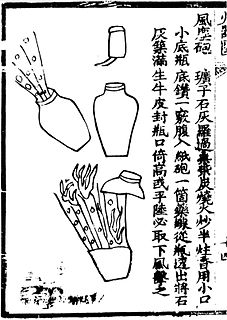
A bomb is an explosive weapon that uses the exothermic reaction of an explosive material to provide an extremely sudden and violent release of energy. Detonations inflict damage principally through ground- and atmosphere-transmitted mechanical stress, the impact and penetration of pressure-driven projectiles, pressure damage, and explosion-generated effects. Bombs have been utilized since the 11th century starting in East Asia.
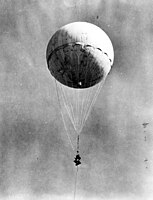
A Fu-Go, or fire balloon, was a weapon launched by Japan during World War II. A hydrogen balloon with a load varying from a 33 lb (15 kg) antipersonnel bomb to one 26-pound (12 kg) incendiary bomb and four 11 lb (5.0 kg) incendiary devices attached, it was designed as a cheap weapon intended to make use of the jet stream over the Pacific Ocean and drop bombs on American cities, forests, and farmland. Canada and Mexico reported fire balloon sightings as well.
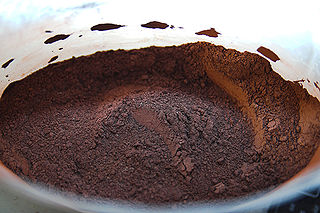
Thermite is a pyrotechnic composition of metal powder and metal oxide. When ignited by heat or chemical reaction, thermite undergoes an exothermic reduction-oxidation (redox) reaction. Most varieties are not explosive, but can create brief bursts of heat and high temperature in a small area. Its form of action is similar to that of other fuel-oxidizer mixtures, such as black powder.

Firebombing is a bombing technique designed to damage a target, generally an urban area, through the use of fire, caused by incendiary devices, rather than from the blast effect of large bombs.

Incendiary weapons, incendiary devices, incendiary munitions, or incendiary bombs are weapons designed to start fires or destroy sensitive equipment using fire, that use materials such as napalm, thermite, magnesium powder, chlorine trifluoride, or white phosphorus. Though colloquially often known as bombs, they are not explosives but in fact are designed to slow the process of chemical reactions and use ignition rather than detonation to start or maintain the reaction. Napalm for example, is petroleum especially thickened with certain chemicals into a 'gel' to slow, but not stop, combustion, releasing energy over a longer time than an explosive device. In the case of napalm, the gel adheres to surfaces and resists suppression.

A shell is a projectile whose payload contains an explosive, incendiary, or other chemical filling. Originally it was called a bombshell, but "shell" has come to be unambiguous in a military context. Modern usage sometimes includes large solid kinetic projectiles that is properly termed shot. Solid shot may contain a pyrotechnic compound if a tracer or spotting charge is used.
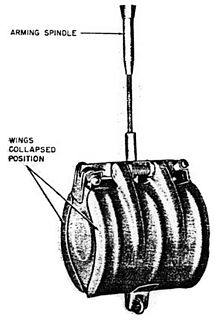
A Butterfly Bomb was a German 2-kilogram (4.4 lb) anti-personnel submunition used by the Luftwaffe during the Second World War. It was so named because the thin cylindrical metal outer shell which hinged open when the bomblet deployed gave it the superficial appearance of a large butterfly. The design was very distinctive and easy to recognise. SD 2 bomblets were not dropped individually, but were packed into containers holding between 6 and 108 submunitions e.g. the AB 23 SD 2 and AB 250-3 submunition dispensers. The SD 2 submunitions were released after the container was released from the aircraft and had burst open. Because SD 2s were always dropped in groups the discovery of one unexploded SD 2 was a reliable indication that others had been dropped nearby. This bomb type was one of the first cluster bombs ever used in combat and it proved to be a highly effective weapon. The bomb containers that carried the SD 2 bomblets and released them in the air were nicknamed the "Devil's Eggs" by Luftwaffe air and ground crew.

A blockbuster bomb or cookie was any of several of the largest conventional bombs used in World War II by the Royal Air Force (RAF). The term blockbuster was originally a name coined by the press and referred to a bomb which had enough explosive power to destroy an entire street or large building through the effects of blast in conjunction with incendiary bombs.

A general-purpose bomb is an air-dropped bomb intended as a compromise between blast damage, penetration, and fragmentation in explosive effect. They are designed to be effective against enemy troops, vehicles, and buildings.

The CBU-100 Cluster Bomb is an American cluster bomb which is employed primarily in an anti-tank mode. It weighs 222 kg (490 lbs) and carries 247 Mk 118 Mod 1 bomblets.
The Lewes bomb was a blast-incendiary field expedient explosive device, manufactured by mixing diesel oil and Nobel 808 plastic explosive. It was created by Lieutenant Jock Lewes, one of the original members of L Detachment SAS in 1941. The SAS needed a combined incendiary and explosive device light enough to be carried by a small group of commandos yet powerful enough to destroy and set fire to aircraft on an enemy airfield. Weighing approximately 1 pound (0.45 kg), the Lewes bomb could be carried in quantity by an individual.

The RRAB-3, nicknamed the Molotov bread basket, was a Soviet-made droppable bomb dispenser that combined a large high-explosive charge with a cluster of incendiary bombs. It was used against the cities of Finland during the Winter War of 1939–1940. The bomb consisted of a cylinder 2.25 metres (7.4 ft) long and 0.9 metres (3.0 ft) in diameter.
This is a glossary of acronyms and initials used for aircraft weapons in the Russian federation and formerly the USSR. The Latin-alphabet names are phonetic representations of the Cyrillic originals, and variations are inevitable.

The M69 incendiary bomblet was used in air raids on Japan and China during World War II, including the firebombing of Tokyo in 1945. It was created by the Standard Oil Development Company, whose work was funded by the Office of Scientific Research and Development. They were nicknamed "Tokyo calling cards". The M69 was a plain steel pipe with a hexagonal cross section 3 inches (76 mm) in diameter and 20 inches (510 mm) long. It weighed about 6 pounds (2.7 kg).

The Fairchild AU-23 Peacemaker is an American armed gunship, counter-insurgency, utility transport version of the Pilatus PC-6 Porter for the United States Air Force. A total of 35 were built under license in the United States by Fairchild Industries, for use during the Vietnam War in the early 1970s. All aircraft were later sold to the Royal Thai Air Force.

The AB 250-2(Abwurfbehälter) was a cluster bomb used by the Luftwaffe during World War II.
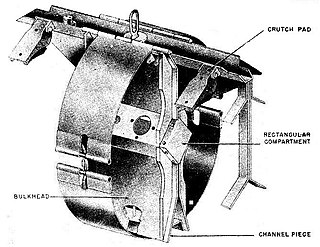
The AB 500-3A(Abwurfbehälter) was a cluster bomb used by the Luftwaffe during World War II.
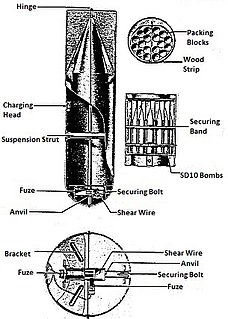
The AB 500-1(Abwurfbehälter) was a cluster bomb used by the Luftwaffe during World War II.
References
- TM 9-1985-4, Japanese Explosive Ordnance. Departments of the Army and the Air force. 1953.